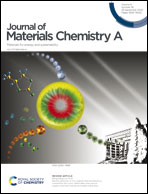Implanting FeCo/C nanocages with tunable electromagnetic parameters in anisotropic wood carbon aerogels for efficient microwave absorption†
Abstract
Adjusting the electromagnetic parameters by decorating magnetic particles for improved impedance matching is an important strategy for obtaining lightweight and efficient carbon-based electromagnetic wave-absorbing materials. In this work, a tomato-like hierarchical porous FeCo/C@WC was prepared for efficient microwave absorption, in which a lightweight anisotropic wood carbon aerogel (WC) was used as a structural assistant, and a MOF-derived graphitized carbon-coated FeCo alloy (FeCo/C) served as a dielectric/magnetic regulator. The tomato-like polystage micro-nano construction was made up of a “pericarp” left by the parallel channels of natural wood, a “pulp tissue” of the MOF-derived nanocage and “seeds” of FeCo nanoalloys embedded in a nanocage. The macroporous wooden shell and mesoporous carbon nanocage gave the composite an excellent hierarchical dielectric coupling network. Meanwhile, the uniformly dispersed FeCo nanoparticles enhanced the magnetic loss to the carbonaceous substrate, allowing for better impedance matching. As a result, the constructed multidimensional FeCo/C@WC exhibited superior wave absorbing ability, in which the maximum reflection loss (RL) reached −47.6 dB and the wide absorption bandwidth was up to 8.9 GHz. These excellent results confirmed that wood-based electromagnetic absorption devices may have a good application prospect.



 Please wait while we load your content...
Please wait while we load your content...